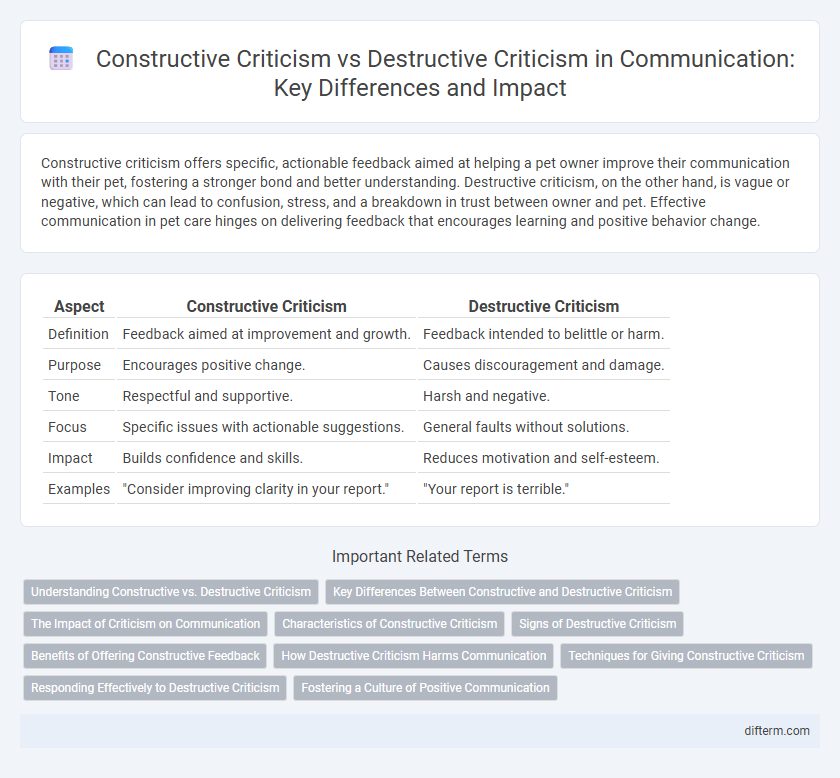Constructive criticism offers specific, actionable feedback aimed at helping a pet owner improve their communication with their pet, fostering a stronger bond and better understanding. Destructive criticism, on the other hand, is vague or negative, which can lead to confusion, stress, and a breakdown in trust between owner and pet. Effective communication in pet care hinges on delivering feedback that encourages learning and positive behavior change.
Table of Comparison
| Aspect | Constructive Criticism | Destructive Criticism |
|---|---|---|
| Definition | Feedback aimed at improvement and growth. | Feedback intended to belittle or harm. |
| Purpose | Encourages positive change. | Causes discouragement and damage. |
| Tone | Respectful and supportive. | Harsh and negative. |
| Focus | Specific issues with actionable suggestions. | General faults without solutions. |
| Impact | Builds confidence and skills. | Reduces motivation and self-esteem. |
| Examples | "Consider improving clarity in your report." | "Your report is terrible." |
Understanding Constructive vs. Destructive Criticism
Constructive criticism provides specific, actionable feedback aimed at improvement, fostering a positive and growth-oriented communication environment. Destructive criticism, however, often targets personal traits, lacks helpful guidance, and can damage morale and relationships. Understanding the differences between these two forms enhances interpersonal skills and promotes effective, respectful dialogue.
Key Differences Between Constructive and Destructive Criticism
Constructive criticism provides specific, actionable feedback aimed at improving performance or behavior, promoting growth and learning through respectful communication. In contrast, destructive criticism focuses on personal attacks or vague negative comments that undermine confidence and motivation without offering solutions. Understanding these key differences enhances effective communication and fosters a positive environment for development.
The Impact of Criticism on Communication
Constructive criticism fosters open communication by promoting clarity, trust, and mutual respect, which enhances problem-solving and collaboration in interpersonal and professional relationships. Destructive criticism damages communication channels, leading to misunderstandings, reduced morale, and increased defensiveness, ultimately weakening teamwork and productivity. Effective communication relies on delivering feedback that encourages growth and improvement without diminishing confidence or motivation.
Characteristics of Constructive Criticism
Constructive criticism is characterized by its focus on specific, actionable feedback that aims to improve performance or behavior without attacking the individual. It emphasizes clarity, empathy, and a positive tone, fostering a supportive environment for growth and learning. This type of criticism encourages open dialogue, builds trust, and promotes continuous development by highlighting both strengths and areas for improvement.
Signs of Destructive Criticism
Destructive criticism often involves personal attacks, vague feedback, and a focus on faults rather than solutions, hindering effective communication and growth. It frequently triggers defensiveness and reduces motivation, as it targets the individual rather than the issue at hand. Recognizing signs such as negative tone, lack of specificity, and absence of constructive suggestions helps distinguish destructive criticism from helpful feedback.
Benefits of Offering Constructive Feedback
Offering constructive feedback fosters personal and professional growth by highlighting specific areas for improvement while maintaining respect and encouragement. It enhances communication skills, builds trust, and motivates recipients to take actionable steps toward development. Constructive criticism contributes to a positive work environment by promoting collaboration and continuous learning.
How Destructive Criticism Harms Communication
Destructive criticism undermines effective communication by eroding trust and creating a hostile environment, which discourages open dialogue and collaborative problem-solving. It triggers defensive reactions, leading to misunderstandings and reduced willingness to share ideas or feedback. Persistent destructive criticism damages relationships, stifles creativity, and hinders conflict resolution within teams and organizations.
Techniques for Giving Constructive Criticism
Effective techniques for giving constructive criticism include focusing on specific behaviors rather than personal traits, using "I" statements to express feelings and perspectives, and offering actionable suggestions for improvement. Emphasizing positive aspects before addressing areas for growth helps maintain a supportive tone and encourages receptiveness. Regularly practicing active listening and ensuring clarity further facilitates productive communication and fosters a growth-oriented environment.
Responding Effectively to Destructive Criticism
Responding effectively to destructive criticism involves maintaining composure and evaluating the feedback objectively, separating personal feelings from the message. Focusing on actionable points within the criticism allows for growth while dismissing unhelpful negativity preserves self-confidence. Employing active listening and asking clarifying questions can transform a potentially harmful encounter into an opportunity for constructive dialogue.
Fostering a Culture of Positive Communication
Fostering a culture of positive communication hinges on emphasizing constructive criticism that encourages growth, clarity, and mutual respect. Constructive feedback focuses on specific behaviors and actionable solutions, boosting morale and collaboration. In contrast, destructive criticism often triggers defensiveness and disengagement, undermining trust and productivity within teams.
constructive criticism vs destructive criticism Infographic

 difterm.com
difterm.com